Elizabeth Kenny was born in Warialda, New
South Wales, Australia in 1886. As a youngster in New South Wales—and later in
Queensland—she was very active. When she was in her teens, she broke her wrist
during a fall from her horse. Her doctor, Aeneas MacDonald, showed her textbook
diagrams of the bones and muscles and how they worked. She was fascinated. She
tried to borrow a skeleton, but was unable to, so she rigged one of her own from ropes and
pulleys.1
She became a bush nurse, traveling through the Australian outback,
treating anyone who couldn't get to a doctor. She did everything a physician might
do, from setting bones to delivering babies.
In 1911, Kenny arrived at a farm to treat a young girl. She found
the girl crippled. Kenny had never seen anything like this. She communicated
with Dr. MacDonald, asking for advice. He responded, "It sounds like Infantile
Paralysis. There's no known treatment, so do the best you can."2
Kenny did. Drawing on her knowledge of the musculoskeletal system,
she applied hot packs to the girl's spasming muscles. The little girl recovered.
Of the twenty children in the district, the six that Kenny treated survived without
complications.3
When World War I broke out, Kenny joined the Australian Medical Corps.
It was then that she earned the title "Sister." She traveled between
Europe and Australia on hospital ships and was wounded in the leg by shrapnel while
working at the front.4
Kenny returned to Australia after the war and continued to care for
patients. She also invented a stretcher designed to transport people in shock.
It was called the Sylvia Stretcher, after the young patient for whom it was
designed. Kenny patented the stretcher and earned money from the royalties for many
years. In 1933, she used these earnings to open her own clinic for the treatment of
polio patients in Townsville, Queensland.5
Kenny's method brought her into controversy with the medical authorities
in Australia. Common knowledge stated that the stronger muscles pulled on the
weakened or paralyzed muscles and created the characteristic poliomyelitic
deformities. The accepted practice was to splint the extremities and hold them
rigid. Kenny believed that the practice actually produced both the deformities and
paralysis. She used hot packs to reduce muscle spasms and the pain they
caused. (Although a polio patient lost motor nerves, their sensory nerves were not
affected, and they were frequently in extreme pain.6
Imagine having a leg cramp for several weeks.) She also moved the patient's
extremities as if guiding them through physical therapy. Although the patient
couldn't work the muscles themselves, the motion helped.7
In 1940, Sister Kenny and her adopted daughter, Mary, came to the United
States. As in Australia, she and her methods were not readily accepted by the
American medical community. To some extent, this may have been due to her physical
appearance. At 5'8" tall, 154 pounds, wearing large feathered hats that some
said made her look like Admiral Lord Nelson, she was an imposing figure in a society that
expected women to be quiet and demure. To her patients, however, her physical
appearance gave them comfort; she looked like a woman who could take on the dread
poliovirus.8
She did not let herself be deterred by opposition. Eventually, she
was allowed to present at the University of Minnesota. And although her methods were
never subjected to strict scientific study, most agreed that the patients in her care did
better than those who were splinted. In fact, in the first year after her methods
gained wide-spread use, the incidence of residual paralysis dropped from 85% to 15%.9
Her methods were so successful that people were able to ignore her other controversial
ideas, such as her belief that polio was a disease of the muscles rather than the nervous
system, and her discouragement of the use of the iron lung except in cases of bulbar
(respiratory) polio.10
In 1942, Kenny established the Sister Kenny Institute in Minneapolis.11
In part because of the controversy surrounding her theories, the National Foundation for
Infantile Paralysis never supported the Institute, although they did fund both the
training of Kenny therapists in at the University of Minnesota and the staffing of
therapists in polio wards.12

Kenny demonstrates her technique.
In 1946, Rosalind Russell starred in a movie about Kenny's life. In
1947, so few patients were being treated with splints that 10,000 of them were sold for
scrap.13
In 1952, Kenny was the most admirable woman in the United States,
according to the Gallup Pole, edging out Eleanor Roosevelt, who had held the top spot for
twenty years.14 That same year, during a home trip to
Australia, she died. She was seventy-two.15
The Sister Kenny Institute is now part of Abbott Northwestern Hospital in
Minneapolis. It is still devoted to the rehabilitation of people who suffer from
physical limitations because of disease, illness, neurological or neuromuscular problems,
injury, or pain.16 Sister Kenny's methods are still a part
of rehabilitative therapy around the world.17


Footnotes
1. "Sister Elizabeth Kenny." Australians
Documentary Series. 1998. http://www.abc.net.au/btn/australians/ekenny.htm.
(1 June 1999)
2. ibid.
3. ibid.
4. Holland, Henry, M.D. "Sister Kenny: Polio
Pioneer." The Lincolnshire Post-Polio Library. 6 June
1997. http://www.zynet.co.uk/ott/polio/lincolnshire/library/drhenry/
srkenny.html. (1 June 1999).
5. ibid.
6. Dobrowolsky, Donna. "Polio." Saskatchewan
Awareness of Post Polio Society, Inc. http://www.sfn.saskatoon.sk.ca/health/polio/polio.html.
(27 May 1999).
7. Holland, Henry, M.D. loc. cit.
8. ibid.
9. Beckstrand, Jan, RN. "History of Nursing
Science." Indiana University Purdue University Indianapolis (professor's
personal Web space). http://www.iupui.edu/~ikux100/petra/histsci.html.
(1 June 1999).
10. Holland, Henry, M.D. loc. cit.
11. "Welcome to Sister Kenny Institute." Sister
Kenny Institute. 1997. http://www.ski-rehab.org/.
(1 June 1999).
12. Holland, Henry, M.D. loc. cit.
13. "And They Shall Walk." National
History Day. http://www.thehistorynet.com/NationalHistoryDay/teacher/willwalk.htm.
(1 June 1999).
14. ibid.
15. "Sister Elizabeth Kenny." Australians
Documentary Series. loc. cit.
16. "Welcome to Sister Kenny Institute."
loc. cit.
17. "Sister Elizabeth Kenny." Australians
Documentary Series. loc. cit. |
